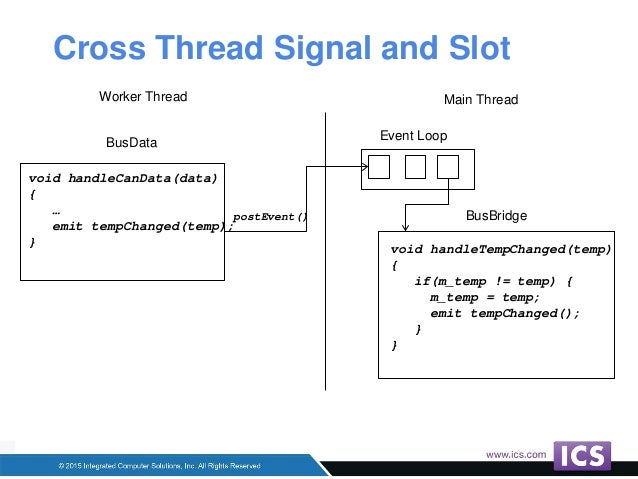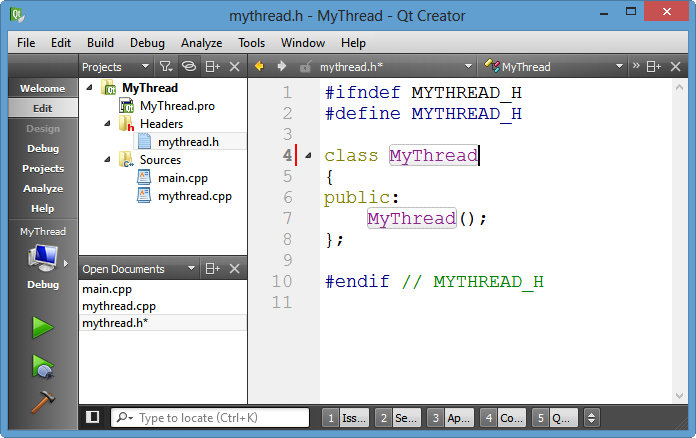Qt Run Slot In Another Thread
- Qt Run Slot In Another Thread Set
- Qt Run Slot In Another Threaded
- Qt Run Slot In Another Thread Size
- Qt Run Slot In Another Thread Pattern
Creating a class and moving it to a thread in a different QThread prevents QWebChannel's queued interaction. To Reproduce: Implement a new class which contains at least 1 public slot (void return) Create an instance of custom class derived from QObject myClass; Create an instance of QThread myClassThread. Qt signal/slot implementation is thread safe, so that you can use it to send messages important, as anything UI related should run in the main thread of Qt, anything that I use this in a different program to have one widget for editing flag like Almost all classes provided by Boost.Signals2 are thread safe and can be used in multithreaded.


Qt offers many classes and functions for working with threads. Below are four different approaches that Qt programmers can use to implement multithreaded applications.
QThread: Low-Level API with Optional Event Loops

Qt's event systemis very useful for inter-thread communication. Every thread may have its own event loop. To call a slot (or any invokablemethod) in another thread, place that call in the target thread's event loop. If you are using Qt and you need to run some code in a separate thread, chances are that you are using QThread for the job.QThread is a very old class in Qt, making its first appearance in Qt 2.2, released on the 22nd of September 2000. The QtConcurrent::run function runs a function in a separate thread. The return value of the function is made available through the QFuture API. This function is a part of the Qt Concurrent framework. Running a Function in a Separate Thread. To run a function in another thread, use QtConcurrent::run.
QThread is the foundation of all thread control in Qt. Each QThread instance represents and controls one thread.
QThread can either be instantiated directly or subclassed. Instantiating a QThread provides a parallel event loop, allowing QObject slots to be invoked in a secondary thread. Subclassing a QThread allows the application to initialize the new thread before starting its event loop, or to run parallel code without an event loop.
See the QThread class reference and the threading examples for demonstrations on how to use QThread.
QThreadPool and QRunnable: Reusing Threads
Creating and destroying threads frequently can be expensive. To reduce this overhead, existing threads can be reused for new tasks. QThreadPool is a collection of reuseable QThreads.
To run code in one of a QThreadPool's threads, reimplement QRunnable::run() and instantiate the subclassed QRunnable. Use QThreadPool::start() to put the QRunnable in the QThreadPool's run queue. When a thread becomes available, the code within QRunnable::run() will execute in that thread.
Each Qt application has a global thread pool, which is accessible through QThreadPool::globalInstance(). This global thread pool automatically maintains an optimal number of threads based on the number of cores in the CPU. However, a separate QThreadPool can be created and managed explicitly.
Qt Concurrent: Using a High-level API
Qt Run Slot In Another Thread Set
The Qt Concurrent module provides high-level functions that deal with some common parallel computation patterns: map, filter, and reduce. Unlike using QThread and QRunnable, these functions never require the use of low-level threading primitives such as mutexes or semaphores. Instead, they return a QFuture object which can be used to retrieve the functions' results when they are ready. QFuture can also be used to query computation progress and to pause/resume/cancel the computation. For convenience, QFutureWatcher enables interactions with QFutures via signals and slots.
Qt Concurrent's map, filter and reduce algorithms automatically distribute computation across all available processor cores, so applications written today will continue to scale when deployed later on a system with more cores.
This module also provides the QtConcurrent::run() function, which can run any function in another thread. However, QtConcurrent::run() only supports a subset of features available to the map, filter and reduce functions. The QFuture can be used to retrieve the function's return value and to check if the thread is running. However, a call to QtConcurrent::run() uses one thread only, cannot be paused/resumed/canceled, and cannot be queried for progress.
See the Qt Concurrent module documentation for details on the individual functions.
WorkerScript: Threading in QML
The WorkerScript QML type lets JavaScript code run in parallel with the GUI thread.
Each WorkerScript instance can have one .js script attached to it. When WorkerScript.sendMessage() is called, the script will run in a separate thread (and a separate QML context). When the script finishes running, it can send a reply back to the GUI thread which will invoke the WorkerScript.onMessage() signal handler.
Using a WorkerScript is similar to using a worker QObject that has been moved to another thread. Data is transferred between threads via signals.
See the WorkerScript documentation for details on how to implement the script, and for a list of data types that can be passed between threads.
Choosing an Appropriate Approach
Qt Run Slot In Another Threaded
As demonstrated above, Qt provides different solutions for developing threaded applications. The right solution for a given application depends on the purpose of the new thread and the thread's lifetime. Below is a comparison of Qt's threading technologies, followed by recommended solutions for some example use cases.
Comparison of Solutions
Qt Run Slot In Another Thread Size
| Feature | QThread | QRunnable and QThreadPool | QtConcurrent::run() | Qt Concurrent (Map, Filter, Reduce) | WorkerScript |
|---|---|---|---|---|---|
| Language | C++ | C++ | C++ | C++ | QML |
| Thread priority can be specified | Yes | Yes | |||
| Thread can run an event loop | Yes | ||||
| Thread can receive data updates through signals | Yes (received by a worker QObject) | Yes (received by WorkerScript) | |||
| Thread can be controlled using signals | Yes (received by QThread) | Yes (received by QFutureWatcher) | |||
| Thread can be monitored through a QFuture | Partially | Yes | |||
| Built-in ability to pause/resume/cancel | Yes |
Qt Run Slot In Another Thread Pattern
Example Use Cases

| Lifetime of thread | Operation | Solution |
|---|---|---|
| One call | Run a new linear function within another thread, optionally with progress updates during the run. | Qt provides different solutions:
|
| One call | Run an existing function within another thread and get its return value. | Run the function using QtConcurrent::run(). Have a QFutureWatcher emit the finished() signal when the function has returned, and call QFutureWatcher::result() to get the function's return value. |
| One call | Perform an operation on all items of a container, using all available cores. For example, producing thumbnails from a list of images. | Use Qt Concurrent's QtConcurrent::filter() function to select container elements, and the QtConcurrent::map() function to apply an operation to each element. To fold the output into a single result, use QtConcurrent::filteredReduced() and QtConcurrent::mappedReduced() instead. |
| One call/Permanent | Perfrom a long computation in a pure QML application, and update the GUI when the results are ready. | Place the computation code in a .js script and attach it to a WorkerScript instance. Call WorkerScript.sendMessage() to start the computation in a new thread. Let the script call sendMessage() too, to pass the result back to the GUI thread. Handle the result in onMessage and update the GUI there. |
| Permanent | Have an object living in another thread that can perform different tasks upon request and/or can receive new data to work with. | Subclass a QObject to create a worker. Instantiate this worker object and a QThread. Move the worker to the new thread. Send commands or data to the worker object over queued signal-slot connections. |
| Permanent | Repeatedly perform an expensive operation in another thread, where the thread does not need to receive any signals or events. | Write the infinite loop directly within a reimplementation of QThread::run(). Start the thread without an event loop. Let the thread emit signals to send data back to the GUI thread. |
© 2020 The Qt Company Ltd. Documentation contributions included herein are the copyrights of their respective owners. The documentation provided herein is licensed under the terms of the GNU Free Documentation License version 1.3 as published by the Free Software Foundation. Qt and respective logos are trademarks of The Qt Company Ltd. in Finland and/or other countries worldwide. All other trademarks are property of their respective owners.